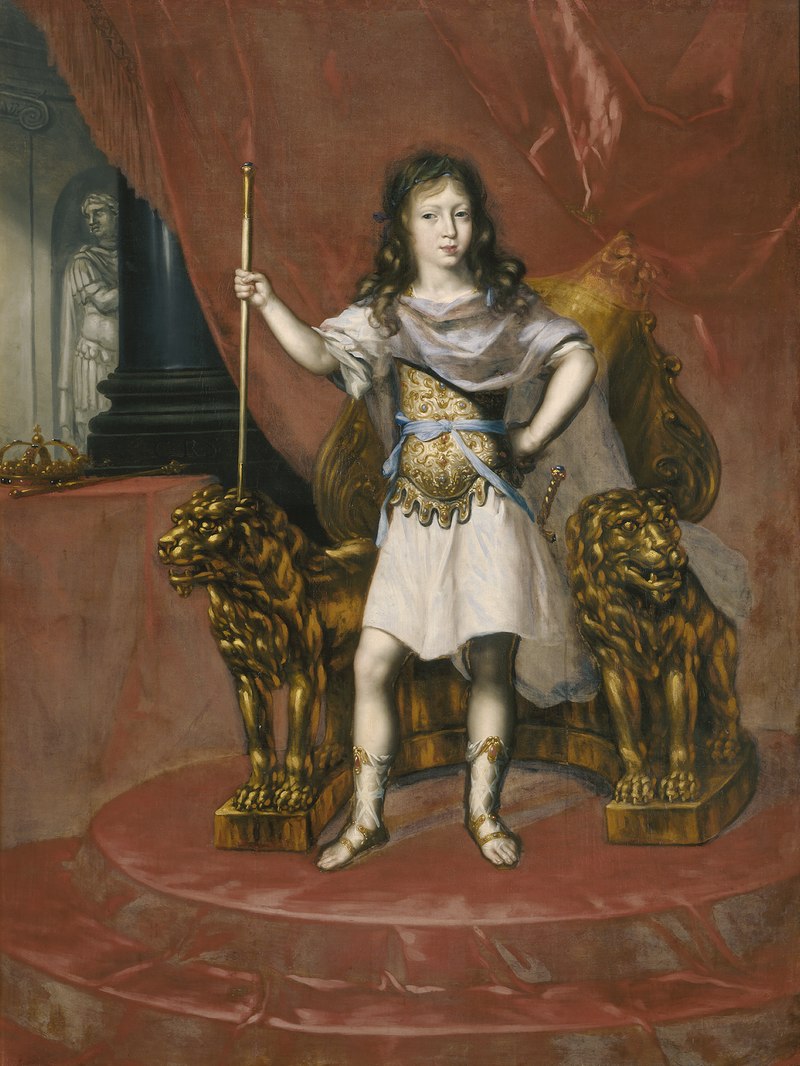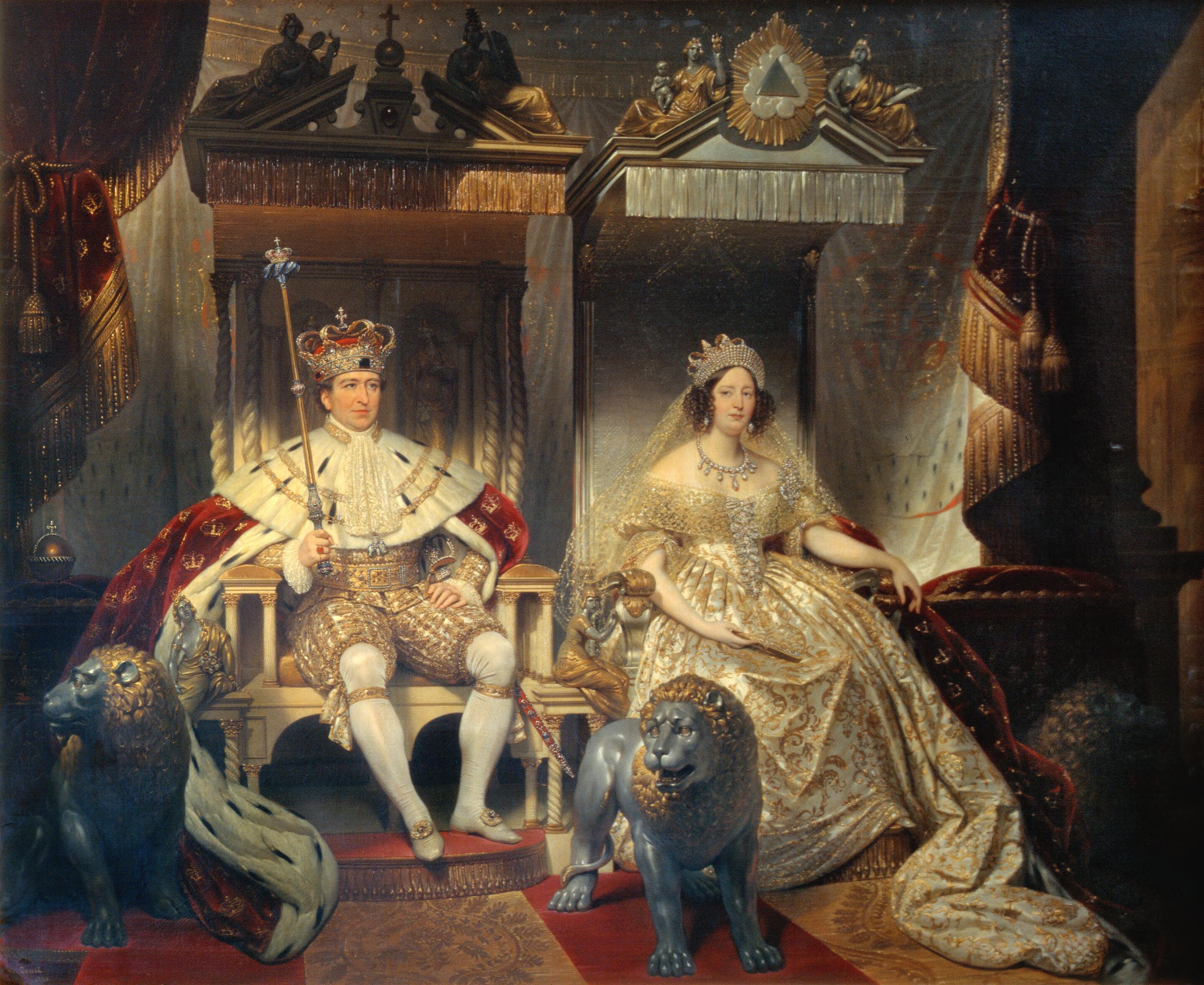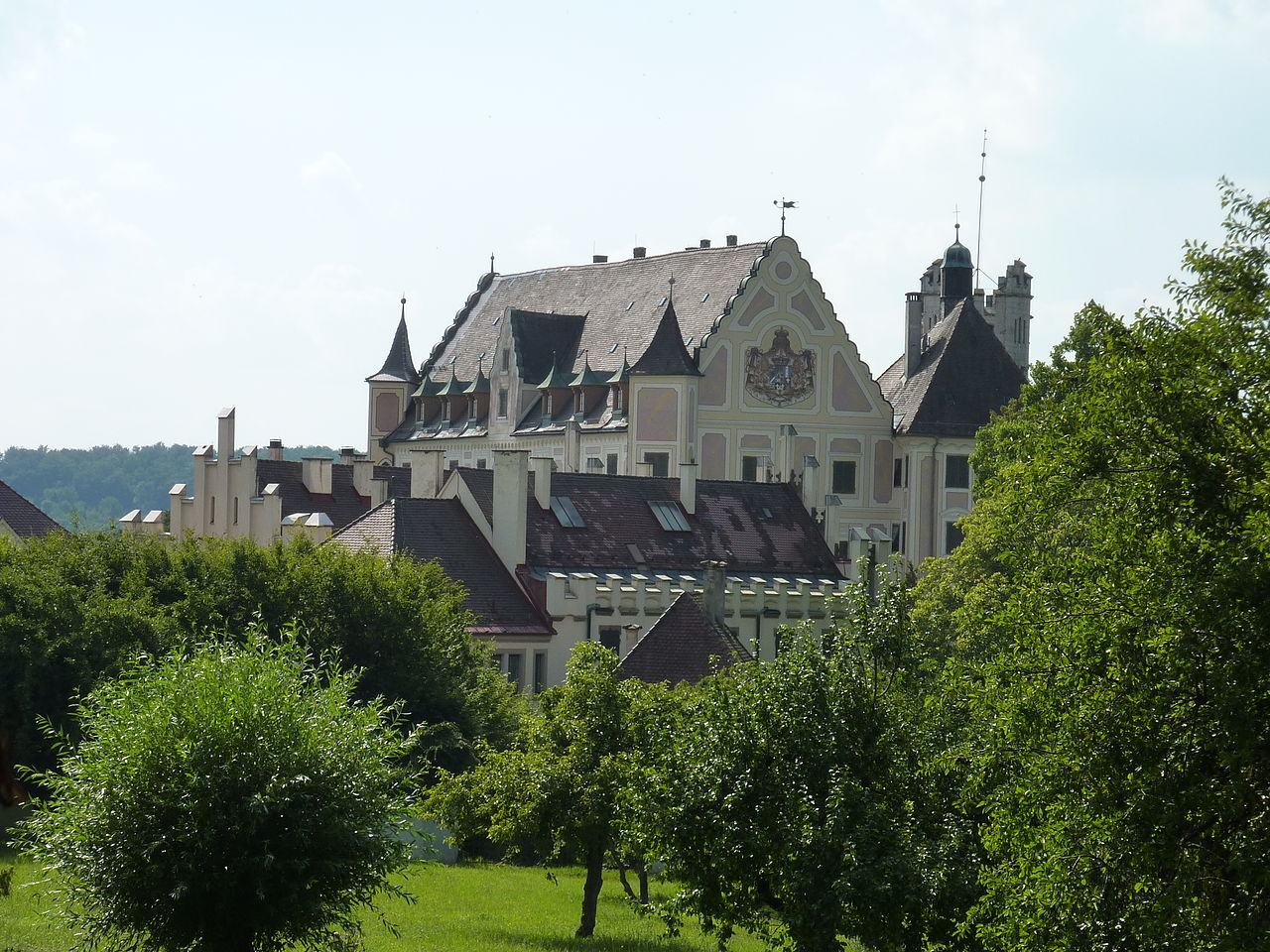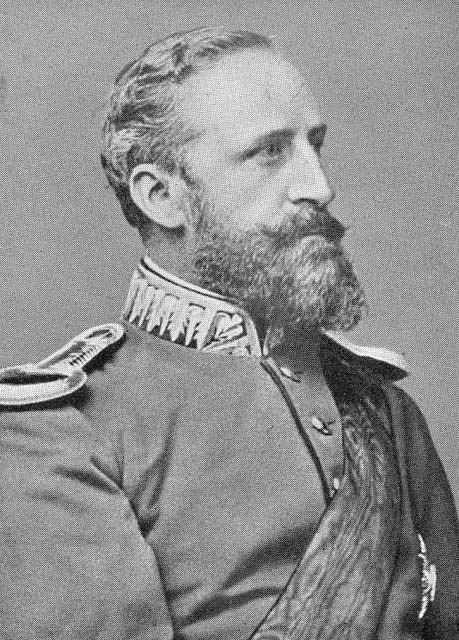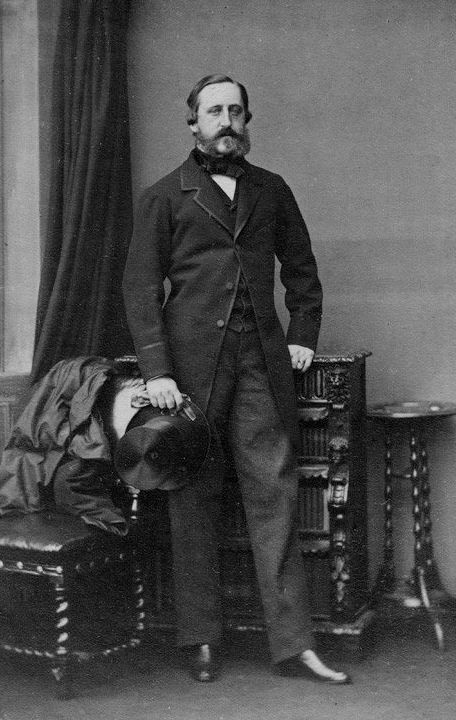by Susan Flantzer
© Unofficial Royalty 2019
Princess Helena of the United Kingdom and Prince Christian of Schleswig-Holstein-Sonderburg-Augustenburg were married on July 5, 1866, at the Private Chapel in Windsor Castle in Windsor, England.
Helena’s Early Life

Helena with her favorite sibling Alfred, by Franz Xaver Winterhalter, 1849; Credit – Wikipedia
Princess Helena was the fifth of the nine children and the third of the five daughters of Queen Victoria of the United Kingdom and Prince Albert of Saxe-Coburg and Gotha. She was born at Buckingham Palace on May 25, 1846. Known within the family as Lenchen, Helena’s childhood was spent at her mother’s various homes, in the care of nurses and nannies. An accomplished artist and pianist from a young age, she was overshadowed throughout her life by her siblings. Helena was closest to her brother Alfred, and the two remained so for their entire lives.
Helena’s life would change drastically in 1861, with the death of her beloved father. She began helping her sister Alice who became an unofficial secretary to their mother. After Alice’s marriage, Helena would continue in this role, along with her younger sister Louise, before the role was primarily taken by her youngest sister, Beatrice.
Helena had a brief romance with Carl Ruland, who had served as her father’s librarian. When the Queen discovered her daughter’s interest in one of the servants, Ruland was quickly dispatched back to Germany. Victoria then began a quest to find Helena an appropriate husband.
For more information on Princess Helena, see Unofficial Royalty: Princess Helena of the United Kingdom, Princess Christian of Schleswig-Holstein
Christian’s Early Life

Prince Christian by Franz Xaver Winterhalter, 1866; Credit – Wikipedia
Prince Christian of Schleswig-Holstein-Sonderburg-Augustenburg, generally shortened to Schleswig-Holstein was born on January 22, 1831, in Augustenborg, Denmark, the sixth of the seven children of Christian August, Duke of Schleswig-Holstein-Sonderburg-Augustenburg and Countess Louise Sophie of Danneskiold-Samsøe. His elder surviving brother was Friedrich VIII, Duke of Schleswig-Holstein who married Princess Adelheid of Hohenlohe-Langenburg, a daughter of Queen Victoria’s half-sister Feodora of Leiningen, Princess of Hohenlohe-Langenburg. Among Friedrich and Adelheid’s children was Augusta Victoria of Schleswig-Holstein who married Queen Victoria’s grandson Wilhelm II, German Emperor and King of Prussia.
While attending the University of Bonn, Christian became close friends with the future German Emperor Friedrich III. This friendship would serve him well in later years, as Friedrich’s wife was Victoria, Princess Royal, the eldest sister of Christian’s future wife.
For more information on Prince Christian, see Unofficial Royalty: Prince Christian of Schleswig-Holstein
The Engagement

Princess Helena and Prince Christian, part of a series of photographs following their engagement; Credit – Wikipedia
Helena was described by her mother as plump, dowdy, uncomplicated, unambitious, obedient, and without charm – which did not help her with marriage prospects. One of Queen Victoria’s requirements for Helena’s husband was that he had to be prepared to live near the Queen so that Helena could continue to be her companion and secretary. This eliminated many potential husbands. The final candidate in Queen Victoria’s search was a 35-year-old impoverished prince, Christian of Schleswig-Holstein, suggested by Queen Victoria’s uncle Leopold I, King of the Belgians.
Being fifteen years older than Helena, Christian was closer in age to Queen Victoria. When Christian was first summoned to meet Queen Victoria, he assumed that the widowed Queen was inspecting him as a new husband for herself rather than as a husband for one of her daughters. Christian was balding, looked older than his age, and was not considered handsome, certainly not the type of prince a 19-year-old princess sees in her dreams. However, Christian was agreeable and easy-going, spoke fluent English, and had been a long-time friend of Helena’s brother-in-law, the future German Emperor Friedrich III.
In August 1865, Queen Victoria and all her children went to Coburg to unveil a statue of Prince Albert. It was there that Helena and Christian first met. The possibility of a marriage between Helena and Christian was not met with unanimous approval within the royal family. The Princess of Wales (formerly Princess Alexandra of Denmark) could not tolerate a marriage to someone who, she felt, took the Schleswig and Holstein duchies away from her own father, the King of Denmark. The Prince of Wales supported his wife in this. Helena’s sister Alice also disapproved as she felt Queen Victoria was pushing Helena into this marriage to ensure that Helena would remain near her side. The fact that Christian was 15 years older than Helena certainly did not help that suggestion. However, Helena and Christian knew they did not have many marriage prospects and were both agreeable to the marriage. Their engagement was announced on December 5, 1865.
The Wedding Site

The original Private Chapel in Windsor Castle, lithograph by Joseph Nash, 1848; Credit – Wikipedia
The Private Chapel in Windsor Castle was created for Queen Victoria by architect Edward Blore between 1840 and 1847. There were niches with marble sculptures, pews, and a large Gothic chandelier hanging from the ceiling. On November 20, 1992, a fire began in the Private Chapel in Windsor Castle when a painter left a spotlight too close to the curtains. The fire caused much damage to Windsor Castle. The Private Chapel was later restored but the new Private Chapel is much smaller, has chairs instead of pews, and is only able to fit thirty people. The new altar was made by Queen Elizabeth II’s nephew David Armstrong-Jones, 2nd Earl of Snowdon, a furniture designer and maker.
The Wedding Guests
This is a complete list from the London Gazette, Issue 23140, 17 July 1866.
Royal Guests
- Queen Victoria, mother of the bride
- The Prince and Princess of Wales, brother and sister-in-law of the bride
- Prince Alfred, Duke of Edinburgh, brother of the bride
- Prince Louise, sister of the bride
- Prince Arthur, brother of the bride
- Prince Leopold, brother of the bride
- Princess Beatrice, sister of the bride
- The Duchess of Cambridge, great-aunt of the bride
- Leopold II, King of the Belgians, first cousin once removed of the bride, and his wife Queen Marie Henriette
- Ernst, 4th Prince of Leiningen, half-first cousin of the bride, and his wife Marie, Princess of Leiningen
- Prince Edward of Saxe-Weimar-Eisenach
- Prince Friedrich of Schleswig-Holstein-Sonderburg-Augustenburg, brother of the groom
- The Maharajah Duleep Singh
The Queen’s Household – participated in the royal, bridegroom’s and bride’s procession
- Elizabeth Wellesley, Duchess of Wellington, Mistress of the Robes
- Susanna Innes-Kerr, Duchess of Roxburghe, Lady of the Bedchamber in Waiting
- The Honorable Mrs. Robert Bruce, Woman of the Bedchamber in Waiting
- John Townshend, Viscount Sydney, Lord Chamberlain of the Household
- Valentine Browne, Viscount Castlerosse, Vice-Chamberlain of the Household
- John Ponsonby, 5th Earl of Bessborough, Lord Steward
- George Brudenell-Bruce, 2nd Marquess of Ailesbury, Master of the Horse
- Lieutenant General The Honorable Charles Grey, Joint Keeper of the Privy Purse, Equerry in Waiting
- Major General Sir Thomas Biddulph, Joint Keeper of the Privy Purse
- Lord Otho Fitzgerald, Treasurer of the Household
- Granville Proby, 4th Earl of Carysfort, Comptroller of the Household
- George Bingham, 3rd Earl of Lucan, Gold Stick in Waiting
- Thomas Foley, 4th Baron Foley, Captain of the Gentlemen-at-Arms
- Henry Reynolds-Moreton, 3rd Earl of Ducie, Captain of the Yeomen of the Guard
- Richard Boyle, 9th Earl of Cork, Master of the Buckhounds
- Major Sir John Cowell, Master of the Household
- Frederick Methuen, 2nd Baron Methuen, Lord in Waiting
- Lieutenant-Colonel W.H.F. Cavendish, Equerry in Waiting
- Lord Alfred Paget, Clerk Marshal
- Colonel The Honorable Dudley F. DeRos
- General The Honorable Sir Edward Cust, Master of Ceremonies
- Lieutenant-Colonel R. Palmer, Silver Stick in Waiting
- Colonel H.F. Ponsonby, Field Officer in Brigade in Waiting
- The Honorable Spencer Ponsonby, Comptroller in the Lord Chamberlain’s Department
- Sir William Martins, Gentleman Usher
- Major General Henry S. Stephens, Senior Gentleman Usher
- Sir Charles G. Young, Garter King of Arms
- Mr. Albert W. Woods, Lancaster Herald
- Mr. Matthew C.H. Gibbon, Richmond Herald
Bride’s Attendant
- Jane, Spencer, Baroness Churchill, Lady of the Bedchamber to The Queen
Bridegroom’s Attendants
- Major General Francis Seymour, Groom of the Robes to the Queen
- Count Rantzau, Gentleman of Honor to the Bridegroom
Foreign Representatives
- Henri-Godefroi-Bernard-Alphonse, Prince de La Tour d’Auvergn, French Ambassador
- Count of Lavradio, Portuguese Ambassador
- Phillip Ivanovich Brunnov, Russian Ambassador
- Christian Emil Krag-Juel-Vind-Frijs, Danish Foreign Minister
- The Hanoverian Foreign Minister
- The Prussian Ambassador
- The Turkish Ambassador
Clergy
- Charles Longley, Archbishop of Canterbury
- Archibald Campbell Tait, Dean of the Chapels Royal, Bishop of London
- Samuel Wilberforce, Lord High Almoner, Bishop of Oxford
- Henry Philpott, Clerk of the Closet, Bishop of Worcester
- Charles Sumner, Prelate of the Order of the Garter, Bishop of Winchester
- Gerald Wellesley, Dean of Windsor
Government Officials
- Robert Rolfe, 1st Baron Cranworth, Lord High Chancellor
- Granville Leveson-Gower, 2nd Earl Granville, Lord President of the Council
- George Campbell, 8th Duke of Argyll, Lord Privy Seal
- John Russell, 1st Earl Russell, Prime Minister and First Lord of the Treasury
- Sir George Grey, 2nd Baronet, Secretary of State for the Home Department
- George Villiers, 4th Earl of Clarendon, Secretary of State for Foreign Affairs
- Edward Cardwell, Secretary of State for the Colonies
- Spencer Cavendish, Marquess of Hartington, Secretary of State for War
- George Robinson, 3rd Earl de Grey, 2nd Earl of Ripon, Secretary for the State of India
- Chancellor of the Exchequer, William Ewart Gladstone
- Edward Seymour, 12th Duke of Somerset, First Lord of the Admiralty
- Edward Stanley, 2nd Baron Stanley of Alderley Postmaster-General
- George Goschen, Chancellor of the Duchy of Lancaster
- Thomas Milner Gibson, President of the Board of Trade
- Charles Pelham Villiers, President of the Poor Law Board
- William F. Cowper, First Commissioner of Works
- Adjutant General, Major-General Lord William Paulet
- Quartermaster General, Lieutenant-General Sir James Hope Grant
Attendants to Other Royalty – some participated in processions
- John Poyntz Spencer, 5th Earl Spencer, Groom of the Stole to The Prince of Wales
- James Hamilton, Viscount Hamilton, Gentleman of the Bedchamber in Waiting to The Prince of Wales
- The Honorable Charles L. Wood, Groom of the Bedchamber in Waiting to The Prince of Wales
- Lieutenant-General Knollys, Comptroller and Treasurer to The Prince of Wales
- Major G. H. Grey, Equerry in Waiting to The Prince of Wales
- George Harris, 3rd Baron Harris, Chamberlain to The Princess of Wales
- Countess of Morton, Lady of the Bedchamber in Waiting to The Princess of Wales
- The Honorable Mrs. Edward Coke, Woman of the Bedchamber in Waiting to The Princess of Wales
- Comte Van der Straten-Ponthoz, Grand Marshal to The King of the Belgians
- Comte Gustav de Lannoy, Chamberlain to The Queen of the Belgians
- Marquise de Trazeguies, Lady in Attendance to The Queen of the Belgians
- Comtesse de Yves de Bavai, Lady in Attendance to The Queen of the Belgians
- Jules de Vaux, Secretary to The King of the Belgians
- Thomas Stonor, 3rd Baron Camoys, Lord in Waiting to Queen Victoria in attendance to The King and Queen of the Belgians
- The Honorable Eliot Yorke, Equerry in attendance to The Duke of Edinburgh
- Major Sir Howard Craufurd Elphinstone, Governor to Prince Arthur
- Lieutenant Walter George Stirling, Governor to Prince Leopold
- Lady Caroline Barrington, Lady Superintendent to Princess Louise and Princess Beatrice
- Lady Augusta Stanley, Lady in attendance to Princess Louise and Princess Beatrice
- Colonel Home Purves, Comptroller of the Household to The Duchess of Cambridge
- Lady Geraldine Somerset, Lady in Waiting to The Duchess of Cambridge
- Lieutenant-Colonel James Oliphant, Gentleman in attendance to The Maharajah Duleep Singh
- Lady Susan Leslie Melville, Lady in Waiting to Princess Helena
- Gardner D. Engleheart, Comptroller to the Household of Prince Christian and Princess Helena
- Lieutenant-Colonel George G. Gordon, Equerry to Prince Christian
Other Guests
- Charles Gordon-Lennox, 6th Duke of Richmond and Frances Gordon-Lennox, Duchess of Richmond
- Walter Montagu Douglas Scott, 5th Duke of Buccleuch and Charlotte Montagu Douglas Scott, Duchess of Buccleuch
- Arthur Wellesley, 2nd Duke of Wellington and Elizabeth Wellesley, Duchess of Wellington
- Augusta, Countess Dornberg, morganatic wife of Prince Edward of Saxe-Weimar-Eisenach
- Prince Victor of Hohenlohe-Langenburg, half-first cousin of the bride, and his morganatic wife Laura, Countess Gleichen
- James Hamilton, 2nd Marquess of Abercorn
- Mary Brudenell-Bruce, Marchioness of Ailesbury
- George Phipps, 2nd Marquess of Normanby and Laura Phipps, Marchioness of Normanby
- Frances Ponsonby, Countess of Bessborough
- Edward Smith-Stanley, 14th Earl of Derby
- Catherine Murray, Dowager Countess of Dunmore
- William Wentworth-Fitzwilliam, 6th Earl Fitzwilliam and Frances Wentworth-Fitzwilliam, Countess Fitzwilliam
- Caroline Edgcumbe, Dowager Countess of Mount Edgcumbe
- John Campbell, 2nd Earl Cawdor and Sarah Campbell, Countess Cawdor
- Emily Townshend, Viscountess Sydney
- George Byng, 7th Viscount Torrington
- Charles Shaw-Lefevre, 1st Viscount Eversley
- Lady Emily Seymour and The Honorable Miss Seymour
- The Honorable Reverend Charles L. Courtenay and Lady Caroline Courtenay
- The Honorable Mrs. Grey and Miss Grey
- Lieutenant-General Jonathan Peel, politician
- The Right Honorable Benjamin Disraeli, future Prime Minister
- Lieutenant-General The Honorable H. Byng and Mrs. Byng
- The Honorable Mrs. Wellesley, wife of Gerald Wellesley, Dean of Windsor
- Major-General The Honorable A. N. Hood, Lady Mary Hood and Miss Hood
- The Honorable Lady Biddulph, wife of Major General Sir Thomas Biddulph, Joint Keeper of the Privy Purse
- Sir James Clark, Baronet, former Physician-In-Ordinary to Queen Victoria
- Elizabeth Couper, Dowager Baroness Couper
- Dr. William Jenner, Physician-In-Ordinary to Queen Victoria
- Sir Richard Mayne, Commissioner of the Metropolitan Police
- Mr. Bernard Woodward, Royal Librarian at Windsor Castle
- Mr. Hermann Sahl, Librarian and German Secretary to Queen Victoria
- Arthur Penrhyn Stanley, Dean of Westminster
- Reverend Henry Ellison, Chaplain-in-Ordinary to Queen Victoria
- Reverend James St. John Blunt, Chaplain-in-Ordinary to Queen
- Dr. Douglas Argyll Robertson, Surgeon Oculist to Queen Victoria
- Miss Louisa Bowater, a friend of Princess Helena
- Lieutenant-Colonel George Ashley Maude, Crown Equerry of the Royal Mews, and Miss E. Maude
- Mr. Frederick Gibbs, tutor to The Prince of Wales and Prince Alfred
- Reverend Henry Mildred Birch, Chaplain to The Prince of Wales
- Reverend William Rowe Jolley, tutor to Prince Alfred
- Reverend George Prothero, Chaplain-in-Ordinary to Queen Victoria, Rector of St. Mildred’s Church, Whippingham, Isle of Wight, where Queen Victoria’s family worshipped when at Osborne House
- Reverend Robinson Duckworth, tutor to Prince Leopold
- Reverend N. Shuldham, tutor to Prince Leopold
- Mr. Adolf Buff, German tutor to Prince Arthur and Prince Leopold
- Miss Sarah Anne Hildyard, tutor to Queen Victoria’s children
- Miss Ottilie Bauer, German tutor to Queen Victoria’s children
- Mademoiselle Norele, French tutor to Queen Victoria’s children
The Supporters and Bridesmaids
Prince Christian’s supporters were his brother Prince Friedrich of Schleswig-Holstein-Sonderburg-Augustenburg and Prince Edward of Saxe-Weimar-Eisenach.
Helena had eight bridesmaids, all of whom were unmarried daughters of British Dukes and Earls:
- Lady Muriel Campbell, daughter of John Campbell, 2nd Earl Cawdor, married Sir Courtenay Edmund Boyle
- Lady Ernestine Edgcumbe, daughter of Ernest Edgcumbe, 3rd Earl of Mount Edgcumbe, unmarried
- Lady Mary Fitzwilliam, daughter of William Wentworth-FitzWilliam, 6th Earl FitzWilliam, married The Honorable Hugh Le Despencer Boscawen
- Lady Albertha Hamilton, daughter of James Hamilton, 1st Duke of Abercorn, married George Spencer-Churchill, 8th Duke of Marlborough
- Lady Caroline Gordon-Lennox, daughter of Charles Gordon-Lennox, 6th Duke of Richmond, unmarried
- Lady Alexandrina Murray, daughter of Alexander Murray, 6th Earl of Dunmore, married Rev. Henry Cunliffe
- Lady Laura Phipps, daughter of George Phipps, 2nd Marquess of Normanby, married John Vivian Hampton-Lewis
- Lady Margaret Montagu Douglas Scott, daughter of Walter Montagu Douglas Scott, 5th Duke of Buccleuch, married Donald Cameron of Lochiel, 24th Chief of Clan Cameron
The Wedding Attire

Princess Helena in her wedding dress; Credit – Wikipedia
Princess Helena’s wedding dress was made from white satin with deep flounces of Honiton lace. The design of the lace featured roses, ivy, and myrtle. The train, also made of the Honiton lace, had bouquets of orange blossom and myrtle attached. On her head, Helena wore a wreath of orange blossoms and myrtle with a veil made of Honiton lace which matched her dress. She wore a necklace, earrings, and a brooch, all of opals and diamonds, a wedding gift from her mother Queen Victoria. In addition, Helena wore bracelets set with miniatures and the Royal Order of Victoria and Albert.
The eight bridesmaids were dressed in white glacé dresses covered with tulle under a long tunic of silver tulle, which was looped up on one side with a chatelaine of pink roses, forget-me-nots, and white heather. The bodice and skirt were also trimmed with pink roses, forget-me-nots, and heather. On their heads, the bridesmaids wore a wreath of pink roses, forget-me-nots, and heather with a long tulle veil.
The Wedding
Embed from Getty Images
The wedding ceremony was held at 12:30 PM on July 5, 1866, at the Private Chapel in Windsor Castle in Windsor, England. At noon, members of the British royal family, along with other royalty and important guests gathered in the White Drawing Room in Windsor Castle. Princess Helena remained in Queen Victoria’s Private Apartments while members of her procession assembled in the corridor outside Queen Victoria’s Private Apartments. Prince Christian, his supporters and members of his procession waited in the Red Room. The Ladies and Gentlemen of The Queen’s Household along with the Ladies and Gentlemen of foreign royalty assembled in the corridor. Ambassadors, Foreign Ministers, Cabinet Ministers, and other guests assembled in the Red and Green Drawing Rooms and were then conducted to their seats. The Archbishop of Canterbury and the other clergy taking part in the wedding ceremony assembled in the Audience Chamber. They then proceeded to the Private Chapel and took their places at the altar.
After the Ambassadors, Foreign Ministers, Cabinet Ministers, and other guests had taken their seats and the clergy had assembled in the Private Chapel, the Royal Procession formed in the corridor outside the White Drawing Room and were conducted to the Private Chapel by the Lord Chamberlain and the Vice-Chamberlain. The Lord Chamberlain and the Vice-Chamberlain then proceeded to the Red Room and conducted Prince Christian’s procession to the Private Chapel. Finally, the Lord Chamberlain and the Vice-Chamberlain proceeded to Queen Victoria’s Private Apartments and conducted Princess Helena’s procession to the Private Chapel. As her father had died in 1861, Helena was escorted by her mother Queen Victoria, her eldest brother The Prince of Wales, and her eight bridesmaids.
As the Bride’s Procession made its way to the Private Chapel, the March from the opera “Scipio” by Georg Friedrich Handel was played. When Helena arrived in the Private Chapel she took her place on the left side of the altar while Queen Victoria was led to her seat.

Princess Helena and Prince Christian; Credit – Royal Collection Trust
Charles Longley, Archbishop of Canterbury performed the entire wedding ceremony. The responses of both Helena and Christian were made in a firm and audible voice and Christian spoke with a decidedly foreign accent. When the Archbishop of Canterbury asked, “Who giveth this Woman to be married to this Man?”, it was Queen Victoria, in lieu of her deceased husband, who answered in a dignified and determined manner. During the ceremony, the choir sang a chorale by William George Cusins, specially composed for the occasion. Cusins was the organist in Queen Victoria’s Private Chapels and played the organ during the wedding ceremony.
When the ceremony was over, Helena was warmly embraced by Queen Victoria and The Prince of Wales. Then, to Ludwig Spohr’s march from the oratorio “The Fall of Babylon”, Helena and Christian proceeded to the White Drawing Room, accompanied by the royal procession and the clergy, to sign the marriage registry along with Queen Victoria, other royalty, and some members of the Royal Household.
Post-Wedding
Embed from Getty Images
Princess Helena and Prince Christian leave Windsor Castle for their honeymoon
Luncheon was served to members of the British royal family and other royalty in the Oak Room at Windsor Castle. Other guests were served a buffet in the Waterloo Chamber. At 4:15 PM, guests desiring to return to London boarded a special train. At the same time, the bride and groom left Windsor by special train for Southampton where a boat would convey them to the Isle of Wight for their honeymoon at Osborne House.
Later that evening at Windsor Castle, a banquet was held in the Waterloo Gallery and an evening party was held in St. George’s Hall.
Children
Helena and Christian had five children:
This article is the intellectual property of Unofficial Royalty and is NOT TO BE COPIED, EDITED, OR POSTED IN ANY FORM ON ANOTHER WEBSITE under any circumstances. It is permissible to use a link that directs to Unofficial Royalty.
Works Cited
- Chomet, Seweryn. (1999). Helena: A Princess Reclaimed. New York: Begell House Inc.
- Google Books. (1866). The London Gazette Issue 23140. 17 July 1866. [online] Available at: https://books.google.com/books?id=xTxEAAAAcAAJ&pg=PA4089&lpg=PA4089&dq=London+Gazette.+Issue+23140.+17+July+1866&source=bl&ots=EnAnytK-0J&sig=ACfU3U36Jz4GH6riAvk5Y2WdCGzEbr4sAA&hl=en&sa=X&ved=2ahUKEwivwaH9r4bkAhWwT98KHe3WCb0Q6AEwDHoECAwQAQ#v=onepage&q&f=false [Accessed 23 Aug. 2019].
- Mehl, Scott. (2015). Prince Christian of Schleswig-Holstein. [online] Unofficial Royalty. Available at: https://www.unofficialroyalty.com/prince-christian-of-schleswig-holstein/ [Accessed 23 Aug. 2019].
- Mehl, Scott. (2015). Princess Helena of the United Kingdom, Princess Christian of Schleswig-Holstein. [online] Unofficial Royalty. Available at: https://www.unofficialroyalty.com/princess-helena-of-the-united-kingdom-princess-christian-of-schleswig-holstein/ [Accessed 23 Aug. 2019].
- Packard, Jerrold. (1998). Victoria’s Daughters. New York: St. Martin’s Press.
- Trove. (1866). MARRIAGE OF THE PRINCESS HELENA. – The Sydney Morning Herald (NSW: 1842 – 1954) – 14 Sep 1866. [online] Available at: https://trove.nla.gov.au/newspaper/article/13136740 [Accessed 23 Aug. 2019].
- Van der Kiste, J. (2011). Queen Victoria’s Children. Stroud: The History Press.









